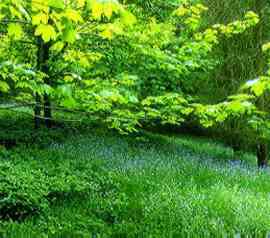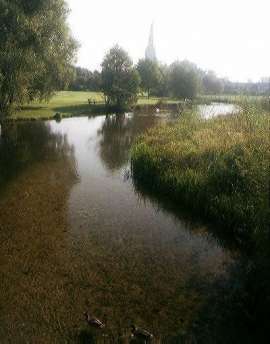Disappearing Habitats in Britain
A habitat is any area where plants and animals can live undisturbed. The word ‘habitat’ comes from a Greek word meaning ‘home’. Even a city is a habitat with wildlife making its home alongside human beings, in and around buildings, but usually we think of wild areas when we speak of habitats.
World-wide there are many wild habitats in danger of disappearing – the tropical rainforest to name just one. If a habitat is destroyed or is changed by humans it can become endangered. Then it follows that the animals and plants living in it become also endangered.
Wild places everywhere are under pressure from human beings. Why is this? Quite simply, there are just too many of us!
There are nearly 7.5 billion people in the world today – about 7 billion more than there were 300 years ago! Here in Britain our population is over 66 million.
An ever-increasing population needs housing, clean water, a supply of food and industry to supply the people’s needs. All this development requires space – and wild habitats are destroyed in the process.
Britain in the Past
 Our countryside today is almost all artificially made. Wolves, bears, lynx, reindeer, moose, beavers and wild boar used to roam much of Britain before humans took control of most of the land. Changes in climate have also impacted habitats - in Europe, over 100,000 years ago there were also elephants, lions and hyenas!
Our countryside today is almost all artificially made. Wolves, bears, lynx, reindeer, moose, beavers and wild boar used to roam much of Britain before humans took control of most of the land. Changes in climate have also impacted habitats - in Europe, over 100,000 years ago there were also elephants, lions and hyenas!
For about 7000 years, following the end of the last Ice Age, nearly the whole of Britain was covered with forest mostly consisting of broad-leaved trees, oak and elm being the most common species. These trees and woodlands provided habitats for many more animals then can be found here today - many of them have now become extinct in this country.
About 5,000 years ago, the Neolithic people in Britain began to clear the forests for cultivation and permanent settlements. These people used flint axes for cutting down trees which they used for fuel and the land was cultivated.
In 500 BC the Celts arrived with their more advanced technologies began to create fields for crops and meadows for cattle. The Celts and Romans mainly concentrated on cultivating light soils, chalk and limestones, on higher ground and they put sheep and cattle on these downlands preventing them from reverting to woodland.
 The Anglo-Saxons, using eight-ox ploughs to turn heavy clay soil, cleared many valleys and much of the farmland of the high ground was abandoned. Beech woodland took over in many places but elsewhere sheep continued to graze, keeping the land clear of trees. This is how the chalk and limestone grasslands were formed. Today they are considered a disappearing habitat, home to several endangered species of flowers.
The Anglo-Saxons, using eight-ox ploughs to turn heavy clay soil, cleared many valleys and much of the farmland of the high ground was abandoned. Beech woodland took over in many places but elsewhere sheep continued to graze, keeping the land clear of trees. This is how the chalk and limestone grasslands were formed. Today they are considered a disappearing habitat, home to several endangered species of flowers.
Most of the remaining forest disappeared during the 16th and 17th centuries to provide timber for boats or charcoal for the iron industry. During this century, even more of our woodlands have been cleared and very few of the scattered woodlands date back to prehistoric times. Most have been replanted at some stage and are poorly managed. Some of the most successful broad-leaved woodlands today are those managed by private estates and pheasant reserves. Another type of ancient British woodland can be found in the highlands of Scotland – the Caledonian pine forests, made up mainly of coniferous Scots Pine Trees.
Today there is a growing movement for 'rewilding'. That is, leaving habitats to develop naturally - without human management, control or intervention. Rewilding also calls for the reintroduction of species that were hunted or pushed to the side and made extinct. In some areas in Britain rewilding projects are taking place that look at the benefits or reintroducing wild boar and beavers.
Artificially Created Habitats
 We have already mentioned that most of our British countryside today is man-made, much of it consists of a landscape of fields and scattered small woodlands joined together with hedges or wire fences. This farmland is the most man-made part of the countryside but even though it cannot be called truly wild habitat, it is still one of the most important habitats in Britain for wildlife – especially if hedges and trees grow around the fields.
We have already mentioned that most of our British countryside today is man-made, much of it consists of a landscape of fields and scattered small woodlands joined together with hedges or wire fences. This farmland is the most man-made part of the countryside but even though it cannot be called truly wild habitat, it is still one of the most important habitats in Britain for wildlife – especially if hedges and trees grow around the fields.
Fields, hedges, the chalk downlands and the heathlands of Britain only exist because they have been created and managed by people. If left to themselves they would eventually revert to woodlands. If you stopped cultivating your garden it would soon be taken over by small shrubs like bramble; this scrubland would be replaced by fast growing trees such as ash and sycamore. Finally, beech and oak trees would dominate. These changes in plant life in a habitat are called succession and if left alone by humans, it continues until a climax is reached. Oak woodland is the commonest climax vegetation in Britain.
Fresh water habitats in Britain may be ponds, lakes, reservoirs, streams and rivers. Most of them have been either made or changed in some way by humans. Today a pond is regarded as an endangered habitat. For centuries the pond was a necessary part of the British landscape. Nearly every village and farm had a pond and it provided water for both people and farm animals. Nowadays we don’t need ponds for water and most of the old ones, being man-made, have become overgrown with plants, built over or polluted. 50% of the conutry's ponds were lost in the 20th Century. Over 80% of all ponds in this country are now in private gardens or school grounds – they are an essential habitat for many species of animals and plants, including the increasingly rare amphibians – the frogs, toads and newts.
Every habitat has its own particular set of plant and animal species. Together the different species make up a community and they all depend on each other in some way.
Credits
Image: Dartmoor, Emma Brice
Information sourced from:
US News and World Report (2014) The 2015 U.S and World Populations [online], Available from: http://www.usnews.com/opinion/blogs/robert-schlesinger/2014/12/31/us-population-2015-320-million-and-world-population-72-billion [accessed 28/05/2015].
Office for National Statistics (2014), Total Population (UK) Mid-2013 Estimate [online], Available from: http://ons.gov.uk/ons/taxonomy/index.html?nscl=Population [accessed 15/06/2015].

 Our countryside today is almost all artificially made. Wolves, bears, lynx, reindeer, moose, beavers and wild boar used to roam much of Britain before humans took control of most of the land. Changes in climate have also impacted habitats - in Europe, over 100,000 years ago there were also elephants, lions and hyenas!
Our countryside today is almost all artificially made. Wolves, bears, lynx, reindeer, moose, beavers and wild boar used to roam much of Britain before humans took control of most of the land. Changes in climate have also impacted habitats - in Europe, over 100,000 years ago there were also elephants, lions and hyenas! The Anglo-Saxons, using eight-ox ploughs to turn heavy clay soil, cleared many valleys and much of the farmland of the high ground was abandoned. Beech woodland took over in many places but elsewhere sheep continued to graze, keeping the land clear of trees. This is how the chalk and limestone grasslands were formed. Today they are considered a disappearing habitat, home to several endangered species of flowers.
The Anglo-Saxons, using eight-ox ploughs to turn heavy clay soil, cleared many valleys and much of the farmland of the high ground was abandoned. Beech woodland took over in many places but elsewhere sheep continued to graze, keeping the land clear of trees. This is how the chalk and limestone grasslands were formed. Today they are considered a disappearing habitat, home to several endangered species of flowers. We have already mentioned that most of our British countryside today is man-made, much of it consists of a landscape of fields and scattered small woodlands joined together with hedges or wire fences. This farmland is the most man-made part of the countryside but even though it cannot be called truly wild habitat, it is still one of the most important habitats in Britain for wildlife – especially if hedges and trees grow around the fields.
We have already mentioned that most of our British countryside today is man-made, much of it consists of a landscape of fields and scattered small woodlands joined together with hedges or wire fences. This farmland is the most man-made part of the countryside but even though it cannot be called truly wild habitat, it is still one of the most important habitats in Britain for wildlife – especially if hedges and trees grow around the fields.